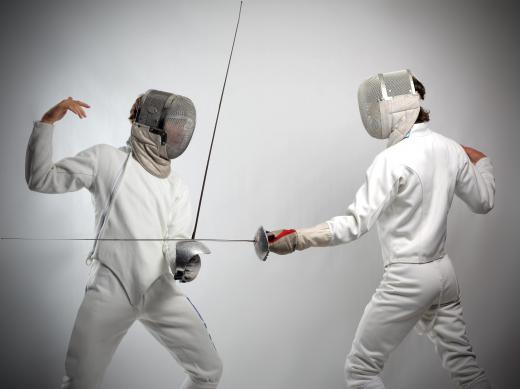Sport fencing is a sword fighting sport which has its roots in the duel, although today it is a stylized dance between two athletes, rather than a fight to the death. Tournaments and schools for sport fencing can be found all over the world, although the sport is most popular in Europe. Students can learn several different styles including French, Hungarian, and Italian, and also learn to fence with a variety of weapons.
Sport fencing is steeped in tradition, and fencers take their sport very seriously. Honor, respect, and courtesy are heavily emphasized in sport fencing, where opponents shake hands and salute before beginning a bout and do the same at the end. In a tournament, sport fencing takes place within a clearly defined 46 foot (14 meter) by six foot (two meter) playing field. The fencers stay within this field during the bout, pursuing each other up and down to gain the upper hand. A fencer scores a point when he or she hits the opponent, or drives the opponent outside the field of play.

Three weapons are used in sport fencing: the epee, the saber, and the foil. The foil was originally developed as a training weapon, and is much lighter and easier to use. Most fencers start out learning foil, so that they become accustomed to handling a blade and learn the rules and traditions of fencing. A foil has a small hand guard and a rectangular blade. Points can only be scored with the tip of a foil on the torso of the opponent: limbs are excluded. Many fencers stick with foil, and it is the predominant weapon used in tournaments.
An epee is a point weapon, with a blade which appears v-shaped in cross section. A large hand guard is used to protect the fencer, who scores with the tip of the weapon only on any part of the body. The saber is a much heavier, slightly curved blade with a y-shaped cross section. It is the only bladed weapon used in sport fencing, and can be used on any part of the body above the waist. All parts of a saber can be used for scoring, and many fencers slash at their opponents, just as sword fighters of old would have done.
Other sport fencing equipment includes a heavy canvas jacket which covers the arms, additional chest protection for female fencers, gloves, and snug pants to protect the legs. Fencing clothing is designed to allow freedom of movement for rapid movements and footwork, so that observers can see what is going on. In competition, fencers also wear special shoes which are designed to help them move quickly and efficiently. Finally, fencers wear a helmet at all times to protect the face and eyes.
Traditionally, a fencing bout will pause whenever a fencer is hit to determine who the point goes to. In a flurried bout where multiple blows might have been received on both sides, the fencer who is hit first must yield the point. Observers help to enforce the honor system, and modern technology has also brought about the use of the electric jacket, which registers a legal hit with a loud noise.
Watching talented sport fencers can be like watching a dance. Sport fencing incorporates rapid, flowing movements, which often seem to come without warning to spectators. Individual fencers try to predict each other's movements and throw each other off with unexpected attacks and lunges. A fencing bout might start with a demure chase up and down the field of play, but end with a flurry of well timed and cleverly executed blows which are thrilling to see.
